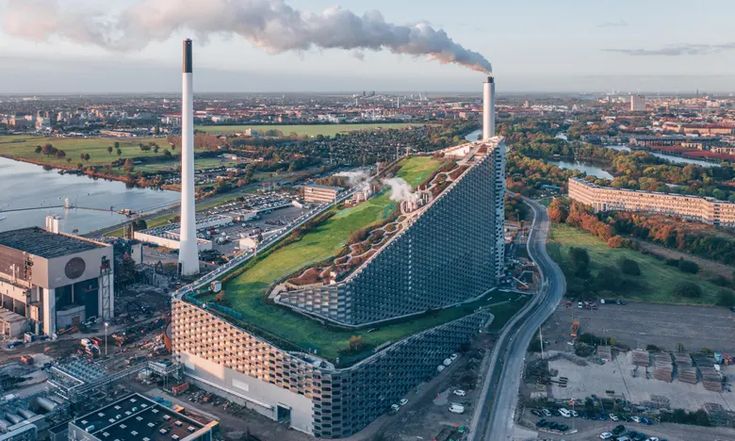Buildings as vectors of urban resilience
In an ever-changing world, where environmental and climate issues take center stage, the question of buildings as vectors of urban resilience has become an emerging priority for those involved in urban design.
This article examines the importance of building resilience by addressing five crucial points: adaptation to climate change, reduction of CO2 emissions, rational use of resources, changing lifestyles, and soil preservation.

1. Adapting to climate change
The increase in climatic disasters, such as floods, storms and heat waves, has made it imperative for buildings to adapt to changing climatic conditions. Building resilience means constructing structures capable of withstanding these events while minimizing damage. The integration of thermal insulation systems, green roofs and energy-efficient windows is essential to strengthen the resistance of buildings to climate change.
Rebuild by Design, United States
This is an innovative program designed to strengthen the resilience of US coastal cities against storms and flooding. It has resulted in projects such as the protection of New York City’s coastline, the Big U, and the creation of resilient parks and green spaces.
Amsterdam, Netherlands
Amsterdam is renowned for its water management and canals. The city has taken an innovative approach by creating “water-resilient streets” that can manage flooding while maintaining urban life.
Rotterdam, Netherlands
Rotterdam is a port city with a history of flooding problems. It has developed a number of resilience projects, including the Maeslantkering, a huge emergency closure system that protects the city from flooding.

2. Reducing CO2 emissions
- Buildings are responsible for around 40% of global greenhouse gas emissions.
- Cities are responsible for over 70% of global carbon emissions, due to the concentration of population, industry and transport in urban areas.
Reducing CO2 emissions is at the heart of the global effort to combat global warming. Buildings, which are responsible for a significant proportion of these emissions, must evolve towards more sustainable designs. The use of more environmentally-friendly building materials, the integration of energy-efficient heating, ventilation and air-conditioning systems, and the adoption of renewable energy sources are all ways of reducing the carbon footprint of buildings.
Copenhagen, Denmark
Copenhagen is often cited as an example of a resilient city due to its efforts to become carbon neutral by 2025. The city has invested heavily in cycling infrastructure, reduced CO2 emissions and prepared its coastal neighborhoods for rising sea levels.
3. Soil conservation
- Around 30% of the planet’s total land surface is devoted to urbanization, agriculture, road infrastructure and industrial areas.
- Urban expansion continues to eat up farmland and natural areas at an alarming rate. Every minute, the equivalent of 30 soccer pitches are lost to urbanization.
Soil preservation is an often overlooked aspect of building resilience. Increasing urbanization can have a detrimental impact on soils, leading to flooding and reduced biodiversity. Sustainable building practices, such as reducing soil sealing, creating green spaces, and using stormwater management techniques, are essential to preserving soils and maintaining a healthy environment.
4. Towards rational use of resources
- Buildings generate almost 40% of the world’s solid waste.
- They consume up to 40% of the world’s fresh water.
- And they consume around 32% of the world’s electricity and are responsible for around 19% of total energy consumption.
The benefits of limiting resource use and reducing waste in building construction cannot be overstated. Traditional construction consumes huge quantities of materials, energy and water, while generating considerable waste.
By encouraging the reuse of materials, we reduce demand for raw materials and help to reduce pressure on ecosystems.
Renovating existing buildings is also a sustainable approach, extending the life of structures and reducing the consumption of resources involved in building new infrastructure. In addition, these practices can reduce construction waste, helping to preserve the environment and reduce the costs associated with waste disposal.
Singapore
Singapore has implemented resilience measures such as water management, local food production, rooftop greening and sustainable urban planning to meet the challenges of urban density and resource scarcity.

5. Changing lifestyles
Lifestyles are changing rapidly, and buildings need to adapt to meet the changing needs of their occupants.
Flexible workspaces, multifunctional buildings and smart neighborhoods are emerging trends that promote optimal use of existing infrastructures. The resilience of buildings translates into their ability to evolve and adapt to meet the changing demands of society.
In conclusion, building resilience is a major challenge for urban planning and real estate professionals. By adapting to climate change, reducing CO2 emissions, keeping pace with changing lifestyles and preserving soil, buildings can play a key role in creating sustainable, resilient environments.
This approach benefits not only the environment, but also the quality of life of those who live and work in these buildings. Building resilience is therefore an approach that deserves a prominent place in the future of urban planning and real estate.
To learn more
https://www.urbanisten.nl/work/rotterdam-watercity-2035
https://www.archdaily.com/493406/the-big-u-big-s-new-york-city-vision-for-rebuild-by-design
https://www.archdaily.com/493406/the-big-u-big-s-new-york-city-vision-for-rebuild-by-design


